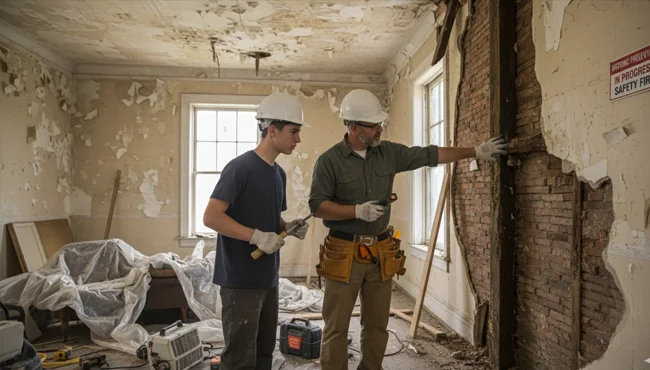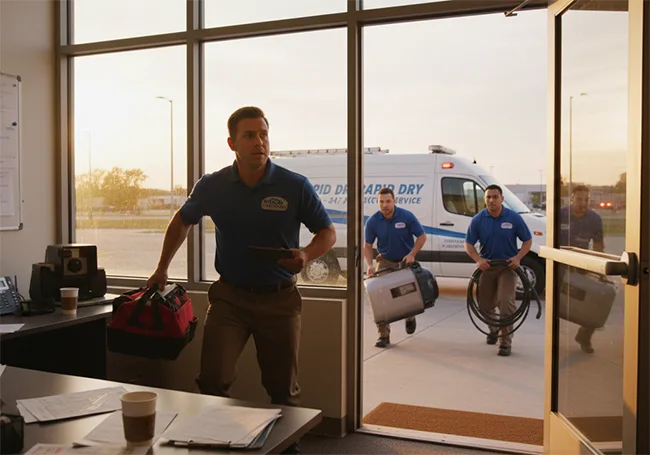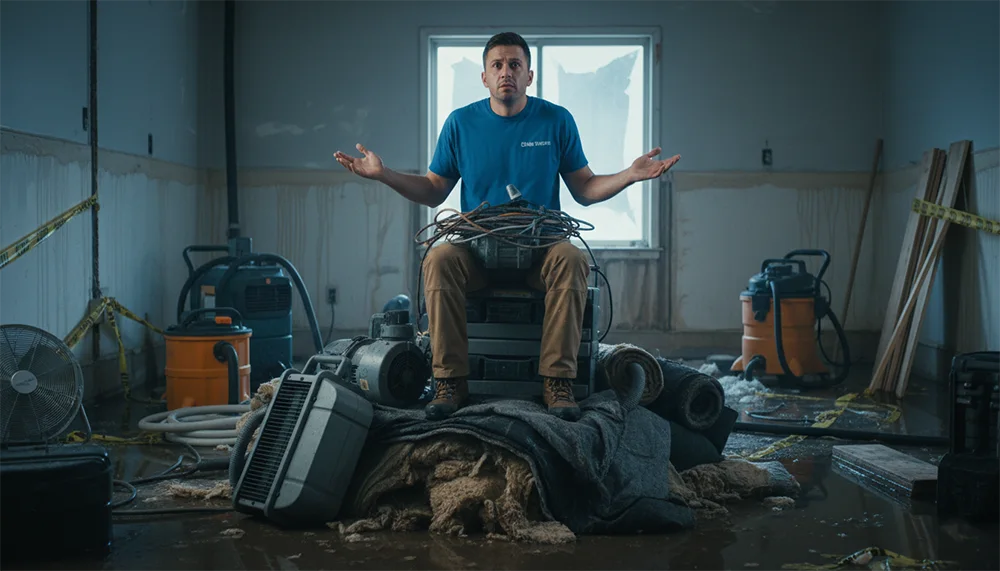The damage restoration business is experiencing unprecedented growth. The U.S. restoration industry reached an estimated $7.1 billion in 2025, growing at a 4.5% CAGR since 2020, with over 35,000 companies now offering restoration services nationwide PuroCleanIBISWorld. For business owners in water, fire, and mold restoration, these numbers represent more than statistics, they signal opportunity, momentum, and urgency.
But here’s the reality: explosive industry growth brings both promise and pressure. More contractors are entering the field. Blue-collar trades are experiencing a renaissance. Competition is intensifying. And the contractors who position themselves correctly right now will capture the lion’s share of this expanding market.
If you’re running a restoration business, or thinking about scaling one, understanding this pivotal moment isn’t optional. It’s survival.
Why the Damage Restoration Industry Is Growing So Fast
Three forces are driving restoration industry growth, and they’re not slowing down.
1. Climate Change and Extreme Weather Events
FEMA reports a 25% increase in flood-related claims between 2020 and 2024, with storm-related damages now costing the U.S. economy over $100 billion annually PuroClean. In 2023 alone, approximately 370 natural disasters were recorded worldwide, resulting in financial losses estimated at $225 billion Astuteanalytica.
The restoration industry isn’t just responding to emergencies, it’s becoming essential infrastructure for climate resilience.
2. Aging Infrastructure Creating Constant Demand
Over 14 million American homes are at risk of flooding Astuteanalytica, and many properties feature decades-old plumbing, HVAC, and electrical systems prone to failure. This creates consistent, year-round demand that goes beyond catastrophic events. Water heater failures, pipe bursts, roof leaks, and appliance malfunctions generate steady revenue streams for restoration contractors.
3. Economic Resilience
The property restoration industry is recession-resistant, specialists are always in demand regardless of economic conditions PuroClean Franchise. When disaster strikes, homeowners don’t have a choice. They need immediate professional help, which creates demand that transcends economic cycles.
The Blue-Collar Renaissance: More Workers, More Respect, More Competition
Here’s where the restoration industry’s story intersects with a broader American trend: blue-collar trades are experiencing a dramatic resurgence.
The Positive Side: Trades Are Thriving
Employment has risen by 5.7% for individuals without a high school diploma in 2024 alone, showing big demand for positions that require certain skills rather than just educational qualifications Appyhere. Blue-collar wages have increased significantly over the past three years, with food preparation and serving sectors seeing a 16.5% increase, while farming, fishing, and forestry occupations showed 14.72% wage growth ResumeCoach.
This isn’t your grandfather’s blue-collar job market. Today’s skilled trades offer:
- Competitive wages rivaling traditional white-collar roles
- Job security that office positions can’t match
- Respect and recognition as essential workers
- Career pathways without crushing student loan debt
Median earnings for high school graduates rose to $45,000 in 2023, up from $39,300 in 2014 Emoryeconomicsreview, and experts say only 1% of blue-collar jobs are at risk of being automated by AI right now Spectra360.
The cultural narrative is shifting. Blue-collar work isn’t a backup plan, it’s a smart choice.
The Challenge: Everyone Sees the Opportunity
But here’s the double-edged sword: the number of restoration businesses has grown by 2.8% per year, with over 60,020 companies now operating in the damage restoration services industry in the United States IBISWorld.
More workers entering trades means more potential employees, but it also means more competitors launching restoration businesses. On the final business day of January 2024, there were 8.9 million job openings available in blue-collar sectors Appyhere, signaling fierce competition not just for contracts, but for skilled labor.
The question isn’t whether the restoration industry is growing. It’s whether you can capture and sustain market share while everyone else is flooding in.
The Real Challenges: Growing Fast Without Growing Smart
Industry growth creates opportunity, but it also exposes operational gaps. Restoration contractors face five critical challenges that separate thriving businesses from those barely surviving:
1. The Workforce Paradox
45% of restoration firms report difficulties in recruiting skilled labor PuroClean. Yes, more people are entering trades, but they’re spread thin across booming industries like construction, HVAC, plumbing, and restoration. About half of contractors have worked at their current company for over 10 years, and finding properly “skilled” employees remains a major challenge Restoration & Remediation Magazine.
The pain point: You can’t scale without technicians. But skilled technicians have options. If your business doesn’t offer clear career pathways, competitive pay, and professional development, you’re losing talent to competitors, or worse, watching them start their own operations.
2. Standing Out in a Crowded Market
When 60,020 businesses compete IBISWorld for the same emergency calls, how do homeowners choose?
Price wars destroy margins. Competing on “fastest response” only works until your competitor gets faster. And without clear differentiation, you become a commodity, interchangeable with every other restoration contractor in your market.
The pain point: If customers can’t immediately see why you’re the obvious choice, they’ll call someone else. In emergency situations, trust must be established in seconds, not sales calls.
3. Insurance Complexity and Claim Processing Delays
Insurance companies are tightening guidelines on what qualifies as a “covered” loss, and homeowners and businesses face longer claim processing times, sometimes delaying mitigation efforts, making damage worse PuroClean.
This creates operational chaos. Delayed payments strain cash flow. Unclear coverage frustrates customers. And contractors get caught in the middle, often advancing work without payment certainty.
The pain point: You can’t wait 60-90 days for insurance companies to pay. But customers expect immediate service. Managing this gap while maintaining profitability requires systems most restoration contractors don’t have.
4. Rising Operational Costs
Inflation has driven up the cost of doing business by 12% or more in some regions, from chemical price hikes to equipment shortages PuroClean. Businesses face average losses of up to $50,000 per water damage incident Astuteanalytica, driving demand, but it also means customers are more price-sensitive when coverage is unclear.
The pain point: Your costs are rising, but customers resist higher prices. Without operational efficiency and strategic positioning, margins evaporate.
5. Rising Operational Costs
56% of contractors expect revenue growth from restoration and remediation work, especially residential contractors Restoration & Remediation Magazine. But growth expectations require professional operations: documented processes, trained staff, marketing systems, and verified credentials.
The pain point: You can’t grow past $500K–$1M annually on hustle alone. Scaling requires systems, trust signals, and operational maturity that many contractors lack.
Why NOW Is the Critical Window
Here’s the uncomfortable truth: industry growth doesn’t guarantee your growth.
The global disaster restoration services market is valued at approximately $74.81 billion in 2025 and is anticipated to reach around $115.34 billion by 2033 Business Research Insights. The pie is getting bigger. But the top five companies account for 51% of market share, indicating strong consolidation among leading disaster restoration service providers Business Research Insights.
This is a consolidation moment. Large franchises and well-positioned independents are capturing disproportionate market share while smaller, unverified competitors fight for scraps.
The next 2-3 years will determine which restoration contractors become market leaders and which remain perpetually stuck at $200K–$400K annually.
What separates winners from losers?
- Third-party credibility that establishes instant trust
- Professional systems that allow scalable growth
- Strategic positioning that differentiates from commodity competitors
- Operational efficiency that maintains margins despite rising costs
- Workforce development that attracts and retains skilled technicians
The contractors who build these foundations now, while the market is expanding, will dominate their regions for the next decade. Those who wait will spend years playing catch-up to competitors who moved decisively.
The Path Forward: Growing Smart in a Growing Market
The damage restoration industry’s explosive growth is real. The blue-collar workforce renaissance is creating more skilled workers. The demand for professional restoration services will only intensify.
But opportunity without execution is just a compelling story. Every contractor sees the same market data. The difference is what you do with it.
Three Strategic Imperatives for 2025
1. Establish Verifiable Trust Immediately
Homeowners choose restoration contractors in seconds during crisis moments. Homeowners place the highest value on clear communication and a strong reputation, with the majority relying on word-of-mouth recommendations, previous contractor relationships, and search engines, with online reviews being particularly influential PuroClean Franchise.
You need instant visual credibility: verified credentials, audit-based certifications, and trust signals that separate you from every other contractor with a truck and a website.
2. Build Systems That Scale
Half of contractors focus on remodeling, with around 20% specializing in water damage restoration, and most companies report annual revenues between $1 million and $4.9 million Restoration & Remediation Magazine. The gap between $200K and $2M isn’t more leads, it’s operational maturity. You need documented processes, trained teams, and systems that function without your constant oversight.
3. Position for Premium Pricing
Rising costs mean you can’t compete on price. You must command premium rates by being worth more. That requires strategic positioning: not the cheapest emergency service, but the most trusted, most professional, most verified restoration partner in your market.
The Bottom Line: Grow Now, or Get Left Behind
The escalating threat of climate change has significantly increased demand for damage restoration services, creating a surge in environmental calamities from wildfires to floods IBISWorld. The market is expanding. The opportunity is real.
But markets don’t care about potential, they reward execution. Every month you operate without professional systems, verified credentials, and strategic positioning is a month competitors use to strengthen their market position.
The restoration contractors who dominate 2025-2030 aren’t waiting to see what happens. They’re building competitive advantages right now, while everyone else is still deciding whether to act.
The question isn’t whether the damage restoration business is growing. It’s whether you’re positioned to capture that growth, or just watching from the sidelines while others scale past you.
The market is moving. The only question is whether you’re moving with it.
At Restoration Expertise, we help restoration contractors stand out in crowded markets through verified certification, strategic positioning, and access to an exclusive nationwide network of elite professionals. Because in a booming industry, trust isn’t just an advantage, it’s everything. Apply for certification or explore the 99-Step Blueprint to transform from overlooked to unavoidable in your market.





